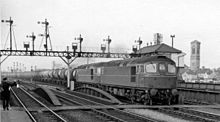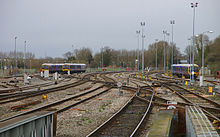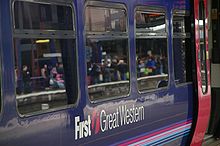- Oxford railway station
-
Oxford 
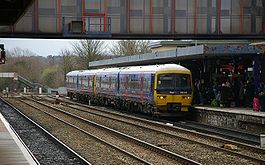
First Great Western 165123 heads a terminating service. Location Place Oxford Local authority Oxford Coordinates 51°45′12″N 1°16′13″W / 51.7534°N 1.2703°WCoordinates: 51°45′12″N 1°16′13″W / 51.7534°N 1.2703°W Grid reference SP504063 Operations Station code OXF Managed by First Great Western Number of platforms 3 Live arrivals/departures and station information
from National Rail EnquiriesAnnual rail passenger usage 2002/03 * 3.649 million 2004/05 *  3.956 million
3.956 million2005/06 *  4.077 million
4.077 million2006/07 *  4.541 million
4.541 million2007/08 *  4.713 million
4.713 million2008/09 *  5.081 million
5.081 million2009/10 *  5.427 million
5.427 millionHistory Original company Great Western Railway Pre-grouping Great Western Railway Post-grouping Great Western Railway 1852 First opened 1971 Rebuilt 1990 Rebuilt National Rail - UK railway stations A B C D E F G H I J K L M N O P Q R S T U V W X Y Z * Annual passenger usage based on sales of tickets in stated financial year(s) which end or originate at Oxford from Office of Rail Regulation statistics. Please note: methodology may vary year on year. Oxford railway station is a mainline railway station serving the city of Oxford, England. It is about 1⁄2 miles (800 m) west of the city centre, northwest of Frideswide Square and the eastern end of Botley Road, and on the line linking Reading with Birmingham New Street. It is also on the line for trains between London Paddington and Hereford via Worcester Shrub Hill. It is a starting point for fast and local trains to London Paddington and for local trains to Reading, Worcester and Bicester Town. The station is operated by First Great Western, and also served by CrossCountry and Chiltern Railways trains.
Contents
History
The Great Western Railway was first opened to Oxford on 12 June 1844[1] with a terminus station in what is now Western Road, Grandpont. In 1845 the Oxford and Rugby Railway began to build its line, starting from a junction at New Hinksey 0.75 miles (1.2 km) south of the GWR terminus. The junction was known as Millstream Junction, and was between the future sites of Hinksey Halt and Abingdon Road Halt, both or which were opened in 1908. The GWR took over the ORR while it was still being built, and opened the line as far as Banbury on 2 September 1850. For just over two years, trains from Oxford to Banbury started at Grandpont, and had to reverse at Millstream Junction in order to continue their journey.[2]
The ORR line included a new through station in Park End Street, so when this opened with the extension of the line from Banbury to Birmingham on 1 October 1852, the original Grandpont terminus was closed to passenger services.[1][3] The old station at Grandpont became a goods depot, but was closed completely on 26 November 1872, the day that the broad gauge tracks were removed north of Didcot. The site of the station was then sold, as was the trackbed from Millstream Junction, some 66 chains (1,300 m) in length.[4][5]
Major subsequent changes were removal of the last 7 ft ¼ in (2,140 mm) gauge tracks in 1872 and of the train shed in 1890–1. The station was substantially rebuilt by the Western Region of British Railways in 1971, further improvements being carried out during 1974 including the provision of a new travel centre,[6] and the new main building and footbridge were added in 1990.
The station has always been busy. In addition to current services, formerly there were others over the Wycombe Railway, Oxford, Witney and Fairford Railway, and Blenheim and Woodstock Branch Line.[citation needed] Through trains from the north to the Southern Railway also typically changed locomotives at Oxford.
It was for a time known as Oxford General station to distinguish it from the London and North Western Railway's Oxford Rewley Road terminus of the "Varsity Line" to Cambridge, which was adjacent and came under joint management in 1933. On 1 October 1951 British Railways closed Rewley Road station to passengers and transferred its services to the former GWR station.[1]
South of the station immediately west of the railway tracks is Osney Cemetery, established in 1848 just before the current station site. Nearby is the site of the former Osney Abbey.
Future plans
Further expansion
Passenger traffic at Oxford is growing rapidly. In the seven years 2003–10 the number of passengers using the station increased by 49%.[7]
In November 2009 it was announced that Oxford station would be expanded. A £10 million joint development between Network Rail and Oxfordshire County Council would create a new platform on part of the station’s long-stay car park. The new platform (south of platform 1) would allow trains to arrive and depart from the same track and reduce the need for empty trains to be shunted around the station. Currently, in busy periods trains can be kept waiting outside of the station for a platform to become available.
A new covered footbridge would also be built over Botley Road to link the station building with the new platform, replacing the existing footbridge to the car park. The new platform was to have been brought into use during 2011, and was to be part of the city and county councils' West End Area Action Plan for the western part of the city centre, which also considers other rail projects such as Evergreen 3 and the Paddington – Oxford electrification.[8]
Project Evergreen 3
Main article: Chiltern Railways#Evergreen 3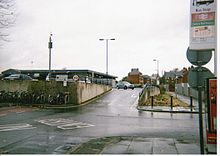 Oxford station's car park as it was in 2002. It is due to be significantly expanded and overhauled along with the rest of the station in the mid 2010s, when the line to Bicester Town is improved. The strip of waste land by the path will become part of the new car park.
Oxford station's car park as it was in 2002. It is due to be significantly expanded and overhauled along with the rest of the station in the mid 2010s, when the line to Bicester Town is improved. The strip of waste land by the path will become part of the new car park.
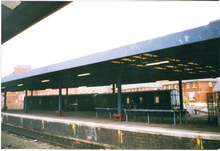 A General Utility Van and a Covered Carriage Truck in a siding at Oxford station in 2004. In 2013 the parcels platform will become a passenger one and extended in to the car park.
A General Utility Van and a Covered Carriage Truck in a siding at Oxford station in 2004. In 2013 the parcels platform will become a passenger one and extended in to the car park.
In August 2008 Chiltern Railways announced Project Evergreen 3, a proposal to construct a 0.25 miles (400 m) link between Bicester Town and the Chiltern Main Line, to allow a new Oxford to London Marylebone service to run via Bicester Town and High Wycombe. The single line between Bicester Town and Wolvercote Tunnel will be doubled and a new station will be built at Water Eaton Parkway. If the scheme is approved, services may start in 2013.
The scheme also includes two new platforms at Oxford station, to be built on the site of the disused parcels depot. The new platforms would initially be five carriages in length, but provision will be made for them to be extended southwards to eight carriages.[9]
Services
Railways around Oxford Legendto Banbury 



to Worcester 



to Bicester to Witney and Fairford 



Water Eaton Parkway Yarnton 



Oxford Road Halt 



Wolvercot Junction 



Wolvercot Platform 



Wolvercote Halt 



Oxford North Junction 






Port Meadow Halt Exchange sidings 






Sheepwash Channel 



Swing bridge Oxford 



Oxford Rewley Road 



Oxford (Grandpont) Goods 



Hinksey Halt 







Millstream Junction Abingdon Road Halt 







Kennington Junction Radley 



Iffley Halt to Didcot 



Littlemore 



Morris Cowley 



BMW Mini terminal 



Horspath Halt 



to Princes Risborough 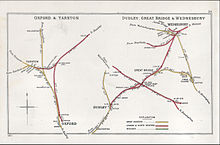 A 1902 Railway Clearing House map of railways in the vicinity of Oxford
A 1902 Railway Clearing House map of railways in the vicinity of Oxford
Preceding station  National Rail
National RailFollowing station Banbury or Tackley Chiltern Railways
Birmingham – Oxford
Limited ServiceTerminus Islip Chiltern Railways
Oxford to Bicester LineTerminus Banbury CrossCountry
Manchester – BournemouthReading CrossCountry
Newcastle – ReadingHanborough First Great Western
Cotswold LineDidcot Parkway Tackley or
TerminusFirst Great Western
Cherwell Valley LineRadley Future service Water Eaton Parkway Chiltern Railways
London Marylebone – OxfordTerminus Historical railways Wolvercot Platform
Line open; station closedGreat Western Railway
Great Western Main LineHinksey Halt
Line open; station closedReferences
- ^ a b c Butt, R.V.J. (1995). The Directory of Railway Stations. Yeovil: Patrick Stephens Ltd. p. 179. ISBN 1 85260 508 1. R508.
- ^ MacDermot, E.T. (1927). History of the Great Western Railway, vol. I: 1833–1863. Paddington: Great Western Railway. p. 300.
- ^ MacDermot 1927, pp. 322, 324–327
- ^ Cooke, B.W.C., ed (November 1957). "The Why and the Wherefore: Original Station at Oxford". The Railway Magazine (Westminster: Tothill Press) 103 (679): 816.
- ^ MacDermot, E.T. (1931). History of the Great Western Railway, vol. II: 1863–1921. Paddington: Great Western Railway. pp. 65–66, 599.
- ^ Slater, J.N., ed (July 1974). "Notes and News: Travel Centre for Oxford Station". Railway Magazine (London: IPC Transport Press Ltd) 120 (879): 361. ISSN 0033-8923.
- ^ Office of the Rail Regulator data: see infobox at head of article.
- ^ Little, Reg (26 November 2009). "Grand plans for Oxford's train station". The Oxford Times (Oxford: Newsquest (Oxfordshire) Ltd): pp. 1, 3.
- ^ "Chiltern Railways plan to make Bicester well connected". Railnews. 2008-08-29. http://www.railnews.co.uk/news/business/2008/08/29-chiltern-railways-upgrade.html. Retrieved 2008-09-07.
Bibliography
- Vaughan, Adrian (1994). The heart of the Great Western. Great Addington: Silver Link Publishing. ISBN 1-85794-026-1.
- Waters, Laurence (1986). Rail centres: Oxford. Ian Allan. ISBN 0-7110-1590-2.
External links
Railway stations served by Chiltern Railways Current Acocks Green · Amersham · Aylesbury · Aylesbury Vale Parkway · Banbury · Beaconsfield · Bearley · Bicester North · Bicester Town · Birmingham Moor Street · Birmingham Snow Hill · Blakedown · Chalfont & Latimer · Chorleywood · Claverdon · Cradley Heath · Denham · Denham Golf Club · Dorridge · Gerrards Cross · Great Missenden · Haddenham & Thame Parkway · Hagley · Harrow-on-the-Hill · Hatton · Heyford · High Wycombe · Islip · Jewellery Quarter · Kidderminster · King's Sutton · Langley Green · Lapworth · Leamington Spa · Little Kimble · London Marylebone · London Paddington · Lye · Monks Risborough · Northolt Park · Old Hill · Olton · Oxford · Princes Risborough · Rickmansworth · Rowley Regis · Saunderton · Seer Green and Jordans · Small Heath · Smethwick Galton Bridge · Solihull · South Ruislip · Stoke Mandeville · Stourbridge Junction · Stratford-upon-Avon · Sudbury & Harrow Road · Sudbury Hill Harrow · The Hawthorns · Tackley · Tyseley · Warwick · Warwick Parkway · Wembley Stadium · Wendover · West Ruislip · Widney Manor · WilmcoteFuture Water Eaton ParkwayCategories:- Buildings and structures in Oxford
- Transport in Oxford
- Railway stations in Oxfordshire
- Former Great Western Railway stations
- Railway stations opened in 1852
- Railway stations served by Chiltern Railways
- Railway stations served by CrossCountry
- Railway stations served by First Great Western
- DfT Category B stations
- British Transport Police stations
- Buildings and structures completed in 1990
Wikimedia Foundation. 2010.


